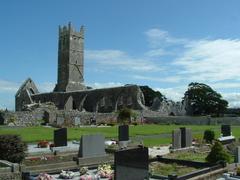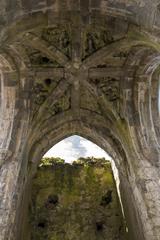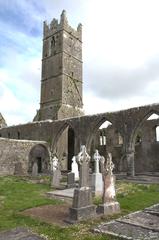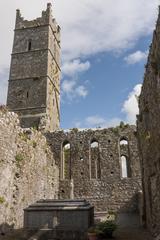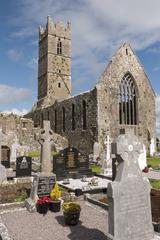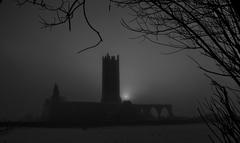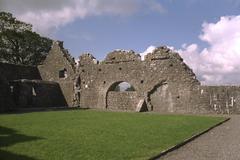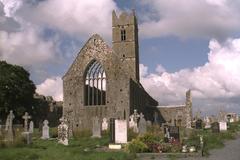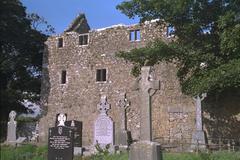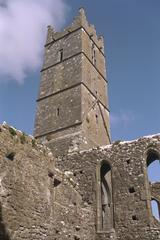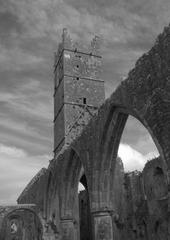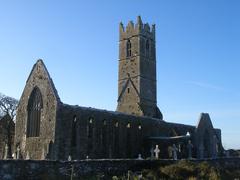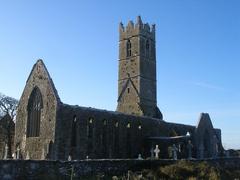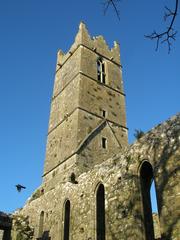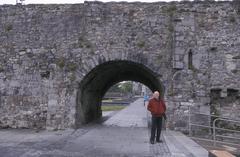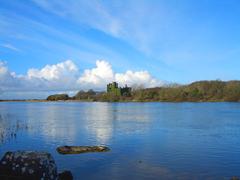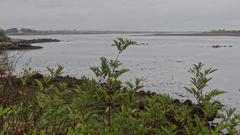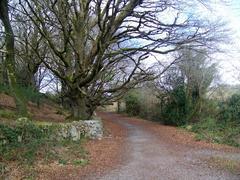
Claregalway Friary Visiting Hours, Tickets, and Historical Sites in Galway
Date: 01/08/2024
Introduction
Discover the Claregalway Friary, a historical gem nestled near Galway, Ireland. Known in Irish as Mainistir Bhaile Chláir, the friary was founded around 1250 by John de Cogan I, an Anglo-Norman adventurer. This site stands as a testament to Ireland’s rich monastic heritage and offers visitors a glimpse into its storied past. From its strategic location near Claregalway Castle and the River Clare to its role in hosting weekly markets and annual fairs since 1252, the friary has been a focal point of religious and community life (Monastic.ie).
The Claregalway Friary’s construction spanned several centuries, showcasing architectural marvels like the chancel’s lancet windows and the iconic three-storeyed bell tower, added in the 15th century. Its resilience through the dissolution of monasteries in the 16th century and subsequent periods of turmoil highlights its enduring significance. Today, it stands as a national monument, open to the public year-round, offering free admission and a chance to explore its artistic and architectural features (Visit Galway).
In this comprehensive guide, we delve into the rich history, architectural beauty, and practical details to help you make the most of your visit to Claregalway Friary. Whether you’re a history enthusiast, an architecture lover, or a curious traveler, this site promises a memorable experience.
Table of Contents
History of Claregalway Friary
Founding and Early Years
The Claregalway Friary, also known as Mainistir Bhaile Chláir in Irish, was founded around 1250 by John de Cogan I, an Anglo-Norman adventurer who played a significant role in the conquest of Connacht circa 1235 (Wikipedia). The friary was strategically located near Claregalway Castle and the banks of the River Clare, serving as a natural route between the port of Galway and the eastern and northern parts of the county (Monastic.ie).
Architectural Development
The friary’s construction spanned several centuries, with the initial nave and chancel church built between the 13th and 15th centuries. The chancel’s six pairs of lancet windows date back to the earliest period of construction, while the slender, three-storeyed bell tower, a typical feature of Irish Franciscan houses, was added in the 15th century (Monastic.ie). The east gable’s traceried window was also part of the later rebuilding efforts.
Patronage and Endowments
John de Cogan I’s founding of the friary was supported by local Irish nobility, including the O’Heynes, who provided a dormitory for the friars. The friary also became the burial site for the powerful de Burgos family, marked by a canopied tomb niche in the north wall (Visit Galway). In 1327, John Magnus de Cogan granted the friars lands and tenements in Clonmoylan near Lough Derg, Co. Galway, in return for a rose presented on the feast of St. John the Baptist, a tradition continued by his heirs (Monastic.ie).
Medieval Significance
The Claregalway Friary quickly became one of the first and most important Franciscan houses in the west of Ireland. It was a center for religious and community life, hosting weekly markets and annual fairs from 1252, likely with the intention of establishing a borough (Monastic.ie). The friary also received an indulgence in 1291 for penitents who visited the church, highlighting its spiritual significance (Monastic.ie).
Dissolution and Decline
The friary faced significant challenges during the dissolution of the monasteries in the 16th century. Crown forces sacked the friary, seizing valuable items such as chalices, crosses, and bells. In 1541, the friary was further ransacked for lead, glass, timber, and slate (Monastic.ie). In 1570, the friary was granted to Sir Richard Burke, who allowed the friars to reside there until 1589 when Sir Richard Bingham converted it into a barracks (Monastic.ie).
Resilience and Revival
Despite these hardships, some Franciscan monks managed to return to the friary in the 17th century and continued to live there until the 19th century. They faced persecution and poverty but received support from local people who respected their faith and learning. The friars maintained a school and a library at the friary, contributing to Irish literature and history. Notable friars included John Colgan, an eminent hagiographer; Bonaventure O’Hussey, a historian and poet; and Anthony Raymond O’Flaherty, an astronomer and mathematician (Visit Galway).
Modern Era
Today, the Claregalway Friary is a national monument under the care of the Office of Public Works. It is open to the public all year round, with free admission. Visitors can explore the ruins of the abbey and admire its artistic and architectural features, learning more about the history and culture of the Franciscan order in Ireland and their role in preserving Irish heritage (Visit Galway).
Archaeological Discoveries
In 2010/11, excavations at the site recovered items such as medieval green glazed imported pottery, fragments of floor tiles, and worked bone pieces. These findings provide valuable insights into the daily lives of the friars and the broader historical context of the friary (This is Galway).
Cultural and Historical Impact
The Claregalway Friary’s rich history and architectural significance make it a vital part of Ireland’s cultural heritage. Its strategic location, patronage by local nobility, and resilience through centuries of turmoil highlight its importance in the medieval and early modern periods. The friary’s contributions to education, literature, and science further underscore its lasting impact on Irish history.
Visitor Information
Visiting Hours
Claregalway Friary is open to the public year-round. Visitors can explore the site during daylight hours. It’s advisable to check the official website or contact the Office of Public Works for the most current visiting hours.
Ticket Prices
Admission to Claregalway Friary is free of charge, making it an accessible attraction for all visitors.
Travel Tips
- How to Get There: Claregalway Friary is located approximately 10 kilometers north of Galway City. Visitors can reach the site by car, taxi, or local bus services.
- Parking: There is limited parking available near the friary, so it’s best to arrive early, especially during peak tourist seasons.
- Accessibility: The site includes uneven terrain and ruins that may be challenging for those with mobility issues. Comfortable footwear is recommended.
- Guided Tours: While there are no official guided tours, visitors can download audio guides or brochures from the official website for a self-guided experience.
Nearby Attractions
While visiting Claregalway Friary, consider exploring the following nearby attractions:
- Claregalway Castle: Located just a short walk from the friary, this restored 15th-century castle offers guided tours and hosts various cultural events throughout the year.
- Galway City: Just a 15-minute drive away, Galway City is known for its vibrant arts scene, historical sites, and lively pubs.
- Turoe Pet Farm: A family-friendly attraction featuring farm animals, a petting zoo, and an adventure park, located about 20 kilometers from Claregalway.
Special Events and Tours
Claregalway Friary occasionally hosts special events such as historical reenactments, cultural festivals, and educational workshops. Check the official website or local tourism boards for upcoming events and tour schedules.
Photographic Spots
The friary’s picturesque ruins, vaulted ceilings, and scenic surroundings make it a popular spot for photography. Don’t miss the Celtic crosses and the bell tower for some stunning shots.
FAQ
What are the visiting hours for Claregalway Friary?
The friary is open year-round during daylight hours. For the most current visiting hours, check the official website or contact the Office of Public Works.
Is there an entrance fee for Claregalway Friary?
No, admission to Claregalway Friary is free.
How do I get to Claregalway Friary?
The friary is located about 10 kilometers north of Galway City. It can be reached by car, taxi, or local bus services.
Are there guided tours available?
While there are no official guided tours, visitors can download audio guides or brochures from the official website for a self-guided experience.
Conclusion
The Claregalway Friary stands as a testament to Ireland’s rich monastic heritage, offering a window into the past through its well-preserved ruins and historical significance. Its enduring legacy continues to attract visitors from around the world, eager to explore its storied past and architectural beauty. Whether you’re exploring the history, architecture, or simply enjoying the serene surroundings, Claregalway Friary is a must-visit destination.
Call to Action
Plan your visit to Claregalway Friary today and discover the rich history and cultural heritage it offers. For more information, download our mobile app, check out related posts on our website, or follow us on social media for updates.
References
- Claregalway Friary. (n.d.). Monastic.ie. Retrieved from Monastic.ie
- Claregalway Friary. (n.d.). Wikipedia. Retrieved from Wikipedia
- Claregalway Friary. (n.d.). Visit Galway. Retrieved from Visit Galway
- An Insider’s Guide to Claregalway. (n.d.). This is Galway. Retrieved from This is Galway

